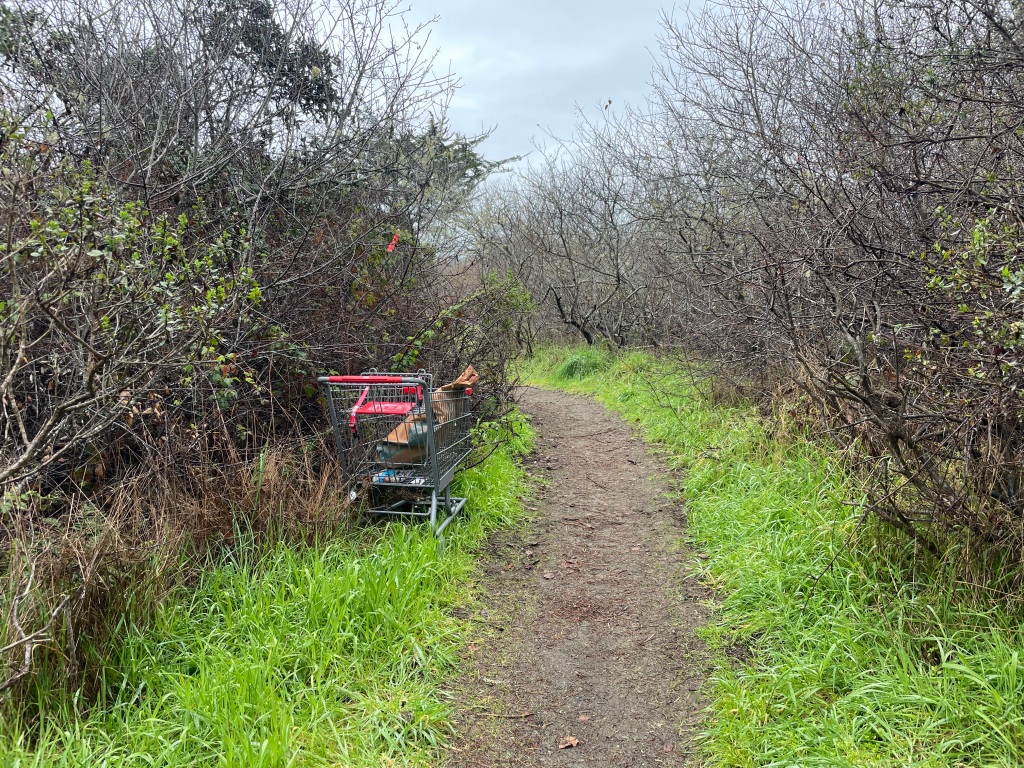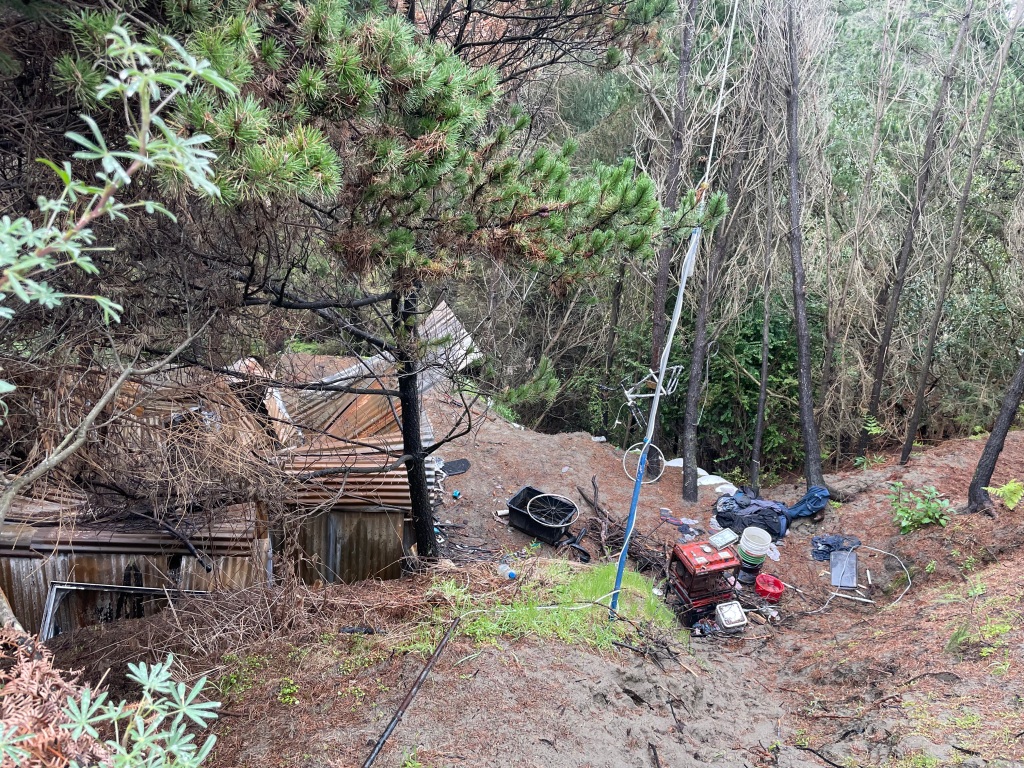I’m in my house, snuggled under a blanket with a fire glowing in the woodstove, a non-alcoholic beer at hand, wondering how to write about today’s experience of hiking through the dunes.
About how the trail leads through coyote brush and blackberry bushes, then opens up to a view of the ocean, waves abounding offshore. About the goldenrod and beach buckwheat scattered along the trail that dips down the sand dune before curving back and up to a ridge running along and then into the dune forest. About the dune forest itself, the southernmost of this type of ecosystem full of Doug Firs, beach pines, endless fungi and reindeer lichen that glows even on the stormiest days.
About the encampment full of tarps, carts and bicycles, about the “Beware of Dog” sign tacked up on a pine tree and the tied-up dog to go with it. About the garbage piles, about the corrugated metal shack smashed and burnt in the dune hollows, about the empty ramen wrappers and plastic bottles sticking out from under huckleberry bushes along the dune forest trail.
About what it feels like to be both an advocate for the poor and an activist for the environment. About the sadness, frustration and anger that filled me as I ended my hike by passing an abandoned CVS shopping cart near the trailhead where I made my exit from the forest onto Peninsula Drive.




This is an update to my January post, “on the finding of human remains in the dunes.” And, I suppose, to my 2016 op-ed, “Who Are the Zombies, the Homeless or Us?” And even this piece from 2013, “Coastal Cleanup Among the Homeless.”
Which is to say, this is not the first time I’ve thought about this, just the closest to home.
Do I need to provide more context? Is anyone in Humboldt unfamiliar with the worsening homelessness crisis that is, to be clear, not at all unique to Humboldt?
- 2013, Devil’s Playground: Bayshore Mall homeless encampment cleanup successful; Critics say people simply moved to other locations.
- 2016, Palco Marsh: Day Two: Evicting the Last Camper and Hauling Out the Last of the Trash
- 2019, Arcata: HOMELESS ENCAMPMENT CLEANUP IN ARCATA SCHEDULED FOR TOMORROW
- 2021, Manila: Campers Evicted from Private Property in Manila
- 2022, Eureka: Saturday Morning Homeless Camp Eviction in Eureka Draws Protesters and Cleanup Crews
- 2023, Eureka, again: CALTRANS AND CHP CLEARED THE GREENBELT IN NORTH EUREKA AGAIN YESTERDAY; ‘WHERE DO YOU WANT ME TO GO?’ TENTS, TRASH, AND TRAUMA IN EUREKA
Encampments dot the county, sprawl along the rivers and take up space in parks. In 2019, a Grand Jury report found that Humboldt’s Approach of Criminalizing the Homeless is Counterproductive. In his story, reporter (and my pal) Ryan Burns writes:
“Perhaps the most interesting part of the report concerns public perceptions of homelessness, noting the ‘opposing impulses’ we have: We want to help the homeless, but we’re also repulsed by them… As a 2017 Washington Post headline put it, ‘Americans want to help the homeless — as long as they don’t get too close.’”
I get it. I want the encampments in the dunes gone. I want the nature protected. I want to hike and meander unimpeded by unsightliness.
I also want to say that I’ve worked with people who’ve succumbed to addiction and ended up living in their cars. To emphasize that I’ve had people I love desperately wind up on the streets. To share that, not that long ago, someone knocked on our door in the midst of what appeared to be a mental health break and we helped her. I want to say all this to insist that I’m a good person, a compassionate person, even as I’m texting my supervisor photos of the encampments accompanied by, in essence, “WTF?!?!??!?!”
I haven’t been a reporter since 2009. This is not an attempt at journalism. (If it was, I’d use direct quotes, cite statistics and talk to the people in the camps.) But I did hit up my county supervisor, Manila Community Services District (MCSD) staff and the Humboldt County Sheriff’s Office (HCSO) to get an update on where the process for – how to convey compassion here? – clearing out the encampments stands. (The murder investigation is way beyond my scope.) The various representatives provided both affirmation and clarification to my timeline, which I now pass on to you.
Friday, Jan. 5: A body is found approximately a half-mile from Peninsula Drive in one of the many homeless encampments in the Manila Dunes.
Tuesday, Jan. 16: A press release goes out identifying the victim and that the death is being considered a homicide.
Tuesday, Jan. 16: The MCSD board includes a resolution to support law enforcement and social services efforts in addressing encampments in the Manila Dunes Recreation Area at their monthly meeting. About 30 residents, mostly from Peninsula Drive, attend, as does Supervisor Mike Wilson and representatives from the HCSO, including Captain Brian Quenell and Connie Beck from the county’s Department of Health and Human Services (DHHS).
Public commenters generally express sympathy for those camping in the dunes, but emphasize the sense of danger felt when trying to use the public trails due to “aggressive dogs” and seeing “people with weapons,” as well as concern about the uncontrolled fires that have been started by people in encampments, the cutting down of trees and clearing of brush, and the amount of garbage and human waste accumulating in an area designated environmentally sensitive habitat.
Beck assures residents that shelter spaces are available for people, even those with dogs, even those with mental illnesses. Captain Quenell explains the holistic approach that has worked in other parts of the county and states that if MCSD provides official direction to enforce “No Trespassing” law, the Sheriff’s office can move forward with providing notice to residents in the encampments that they will have to move and, crucially, can work with DHHS to connect people with services to assist them in getting help. MCSD votes to do this. Residents feel heard and hopeful.
Wednesday, Jan. 17: HCSO stages at the south end of Peninsula Drive and in the parking lot of Redwood Coast Montessori. They map the encampments, deliver notices and otherwise start the process of alerting people they’ll need to move out and informing them help is available. (The murder investigation is also underway.) Notably, officers report that every dog encountered is leashed or on a rope. (Unrestrained dogs more often belong to residents and beachgoers that drive to Manila to take their canine to the beach.)
January/February: Someone torches the corrugated metal shack that, I think, was the home of the murder victim. Meanwhile the CCCs clean up some of the campsites.

Wednesday, Feb. 28: HCSO again stages in the school parking lot for the purpose of taking DHHS workers and a veterinarian out to the encampments to assist in connecting people to resources. The person I spoke with said many of the people want services. She also relayed that one person who maintains an encampment owns a home in Manila, but has a PTSD-induced fear of being inside.
Monday, March 4: The encampments look – to me – worse than ever, although after emailing further with a neighbor, I agree that “worse” is subjective. Everyone official assures me that DHHS, HCSO and MCSD will keep applying as comprehensive and compassionate as possible an approach to clearing out all the illegal campsites within the next couple months. No one expects this to be a solution for the problem of homelessness. But some people might find help.
That’s the hope.